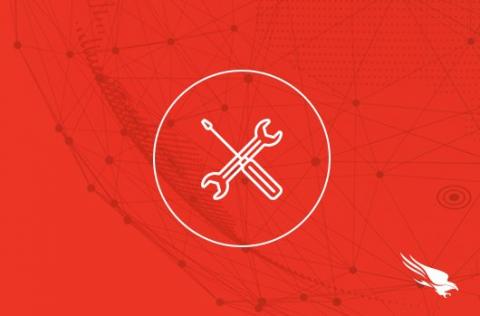Security | Threat Detection | Cyberattacks | DevSecOps | Compliance
October 2023
Protecting Users from Malicious Sites with Falcon for Mobile
Today, mobile devices are ubiquitous within enterprise environments. But with their proliferation, it provides adversaries with yet another attack surface with which they can target users and cause a breach. From phishing attacks to malicious apps, mobile users tend to let their guard down and potentially click on obfuscated links to malicious sites. Falcon for Mobile protects users by preventing connections to malicious sites on both iOS and Android devices.
Five Reasons Why Legacy Data Loss Prevention Tools Fail to Deliver
Like so many legacy technologies, legacy data loss prevention (DLP) tools fail to deliver the protection today’s organizations need. Implementation challenges, visibility gaps and inconsistent policies negatively impact customers and make data breaches far too easy for adversaries. With U.S. data breach costs averaging a staggering $4.45 million last year, organizations need a way to better secure their data as cloud adoption accelerates and IT environments evolve.
Falcon Cloud Security Kubernetes Admission Controller: Demo Drill Down
Falcon Exposure Management Active Asset Scanning: Demo Drill Down
CrowdStrike Services Offers Incident Response Executive Preparation Checklist
Within your incident response plan, there typically is (or should be) a trigger to notify your executive team of an impending crisis. While many organizations believe they’ve worked out the logistics of gathering leadership on the phone, getting decisions made, and garnering their support for your proposed response plan, they often find out in the heat of an incident that the leadership team is miles apart in your understanding of what happens next.
Small Screens, Big Risks: Falcon for Mobile Releases New Innovations to Accelerate Detection and Response for Mobile Threats
Mobile devices have become critical endpoints for accessing enterprise applications, systems and data. Adversaries know this all too well, as evidenced by the growing numbers of attacks that target mobile devices. Verizon’s 2022 Mobile Security Index found almost half (45%) of enterprises had recently suffered a mobile-related compromise involving devices in the last 12 months — almost double the amount compared to the year prior.
CrowdStrike Recognized by Forrester as a Leader in Endpoint Security with the Highest Score in the Current Offering Category
CrowdStrike has been named a Leader in The Forrester Wave™: Endpoint Security, Q4 2023, the latest recognition in a string of accolades for our market-leading cybersecurity solutions delivered from the unified, AI-native CrowdStrike Falcon® platform. In the report, Forrester identified the 13 most significant endpoint security providers and researched, analyzed and scored them based on 25 criteria. Our highlights include.
Getting Value from Your Proxy Logs with CrowdStrike Falcon LogScale
How Well Do You Know Your Attack Surface? Five Tips to Reduce the Risk of Exposure
In an increasingly connected digital landscape, the security of your organization’s data and publicly facing assets is more critical than ever. According to the CrowdStrike 2023 Threat Hunting Report, more than 20% of all interactive intrusions are associated with the exploitation of public-facing applications. As an organization’s attack surface expands and cyberthreats proliferate, it is imperative IT and security teams take a proactive approach to safeguarding their digital footprint.
CrowdStrike Partners with Box to Add Automated Protections Against Security Breaches and Data Loss
The risk of cyberattacks continues to grow for small to medium-sized businesses (SMBs). Today, a staggering 70% of cyberattacks target SMBs, a scourge that cost organizations with fewer than 500 employees an average of $3.31 million USD in 2022, up 13.4% over the previous year. Adversaries tend to take the path of least resistance. This often means targeting small businesses, which face many of the same security threats as large organizations but lack the resources to defend against them.
Getting Value from Your Proxy Logs with Falcon LogScale
All web traffic flowing out of your company network should be passing through a web proxy. These proxy logs are a great resource for threat hunting and security investigations, yet they often translate into extremely large volumes of data.
See Falcon Exposure Management In Action
See Falcon Intelligence in action
Enabling Breach Prevention on Red Hat OpenShift Service on AWS (ROSA)
As organizations increasingly deploy business-critical workloads to managed cloud services, enforcing strong security practices needs to be a top priority. While many managed cloud service providers do a good job of protecting the cloud and infrastructure itself, it’s the responsibility of the customer to protect what’s running inside the cloud.
Falcon LogScale High Speed Search: Demo Drill Down
Falcon LogScale Live Dashboards: Demo Drill Down
CrowdStrike vs. Microsoft Defender for Endpoint: A Cybersecurity Leader Compares EDR Tools
CrowdStrike customers tend to stay with CrowdStrike, typically starting with endpoint detection and response (EDR), then expanding to other attack surfaces as they consolidate their cybersecurity with the CrowdStrike Falcon® platform. But what happens when a business that uses and trusts CrowdStrike is forced to adopt Microsoft Defender due to a divestiture? That’s exactly what happened to this CrowdStrike customer, a major American retailer.
Three Recommendations for a Next-Generation Cybersecurity Framework
Cyberattacks evolve daily, and defenders are forced to adapt at the same rate. Cybersecurity best practices, however, are updated and codified much less frequently. There is broad experimentation in the field, and it takes some time for authoritative working groups to sort out which new practices and controls are practical and consistently effective for a large cross-section of users. Some guidelines and standards are updated every year or two and others much less frequently.


















